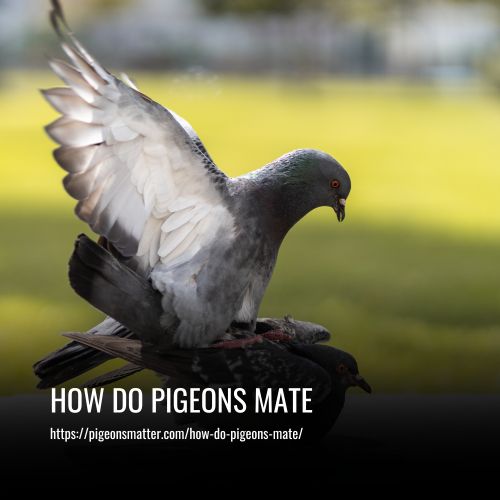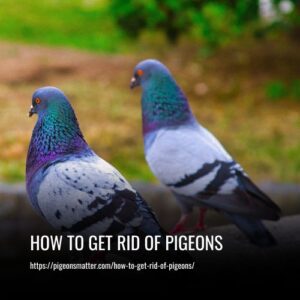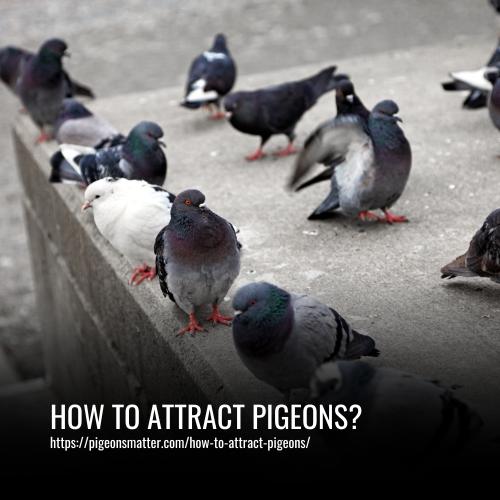Pigeons are common birds found in urban and rural areas around the world. One of the fascinating behaviors of pigeons is their mating ritual. Understanding how pigeons mate can provide insight into their behavior, social structure, and reproductive patterns.
In this article, we will explore the mating behavior of pigeons, including their courtship displays, pair bonding, and nesting habits. By delving into the mating habits of pigeons, we can gain a better appreciation for these often overlooked birds and their important role in the ecosystem.

The Mechanics of Pigeon Mating
Pigeon mating involves a specific set of mechanics that ensure successful reproduction.
1. Male Preparation
Male pigeons prepare for mating by producing more sperm, resulting in their cloacas swelling more than females. This physiological change allows them to transfer an adequate amount of sperm during mating.
2. Female Preparation
Female pigeons also prepare for mating by positioning themselves to facilitate the mating process. They bend down, allowing their cloaca to align easily with the male’s during copulation.
3. Cloacal Kiss
During copulation, the male pigeon climbs onto the female’s back end and they engage in a “cloacal kiss.” This term refers to the touching of their cloacas, which are the reproductive openings. It is through this contact that sperm is transferred from the male to the female.
4. Sperm Transfer
As the male’s sperm is introduced to the female’s cloaca, the female has the ability to suck up the sperm into her ovaries. This process ensures that fertilization can occur and increases the chances of successful egg production.
5. Multiple Mating
To maximize the chances of successful egg production, pigeons may mate multiple times within a week. This strategy increases the likelihood of fertilized eggs being produced.
Understanding the mechanics of pigeon mating is crucial for those interested in breeding or studying these birds’ reproductive behaviors.
Pigeon Mating Process
The mating process of pigeons involves several behaviors and stages. Here is a breakdown of the pigeon mating process:
1. Finding a Mate
Male pigeons engage in various mating displays to attract a lifelong mate. These displays can occur on the ground or in the air. Ground displays are used to catch the attention of female pigeons, while aerial displays help establish territory boundaries.
2. Courtship Feeding
Male pigeons engage in courtship feeding, where they actively search for food to offer to their potential mate. This behavior showcases the male’s ability to provide for the female and is a display of his dedication.
3. Mate Guarding
Male pigeons also practice mate guarding. This means they actively prevent other males from mating with their chosen partner. It is a protective behavior that ensures the male’s exclusivity in mating with the female.
4. Egg Laying
Approximately 12 days after successful mating, the female pigeon will lay 1-3 eggs. Both the male and female pigeons take turns incubating the eggs, sharing the responsibility of keeping them warm and safe.
5. Incubation
The incubation period for pigeon eggs is usually around 16-18 days. During this time, the male and female take turns sitting on the eggs to maintain a consistent temperature and ensure proper development.
What Are A Pigeon’s Mating Habits
Pigeons are monogamous creatures and mate for life. They go through a courting stage before building a nest together and mating. If one mate dies, the other may find a new partner. Each pair of pigeons typically has two nests, and the nests are made out of materials like hay or tobacco stems.
Male pigeons display certain behaviors, such as cooing and showing off, to attract a female mate. If the female is interested, she becomes friendly with the male and they select a place to build a nest. The female will lay eggs, and both parents take turns sitting on them. Pigeon offspring grow quickly, and the parents provide nourishment through “pigeon milk” and partially digested food.
In some cases, pigeons may be infertile and unable to produce offspring. In these situations, the pair may need to be separated to find new mates.
Pigeon’s Sexual Organs
Pigeons have a unique reproductive system where all functions are tied to their anal tract, known as the cloaca or vent. This channel serves as both the digestive and excretory tract, as well as the reproductive tract. It allows for the passage of male sperm to the female’s ovaries. Interestingly, both male and female pigeons have the same reproductive organ, which can make the act of sex somewhat awkward.
The Cloaca
The cloaca is a chamber and outlet found in both male and female pigeons. It serves as the opening for the intestinal, urinary, and genital tracts. In male pigeons, the cloaca also houses the testes, while in female pigeons, it houses the ovaries. During the mating season, both male and female pigeons experience swelling or inflation of their cloaca. However, the males tend to inflate more as the cloaca is responsible for producing and holding sperm.
The cloaca provides a physical difference between males and females during the breeding season. It is one way to determine the gender of a pigeon based on the swelling and inflation of the cloaca.
When Are Pigeons Expected To Mate
Pigeons are able to mate and breed at any time of the year due to their ability to produce crop milk. They can mate up to six times a year, with the entire process, including egg laying and hatching, taking only a few weeks. Female pigeons typically lay their eggs shortly after mating, and the eggs hatch after eighteen days.
Pigeons are more likely to breed when the weather conditions are favorable and there is abundant food available in their surroundings. Urban areas usually provide ample food sources, allowing feral pigeons to mate consistently throughout the year.
What Are the Signs of Pigeon Mating
Recognizing the signs of pigeon mating is important for pigeon owners or enthusiasts. Here are some clear indications that pigeons are ready to mate or already in the mating phase:
1. Mating Dance
During courtship, male pigeons perform a physical display known as a mating dance. This can involve various behaviors specific to mating rituals, which are distinct for both males and females.
2. Nest Building or Preparation
When pigeons are ready to mate, they will start building a nest. They may begin collecting nesting materials such as feathers, grass, and twigs in preparation. Alternatively, they may build a nest first and then seek out a mate. In some cases, pigeons may choose a preferred location and build the nest together after finding a mate.
3. Mutual Preening
Once a bond is established between pigeons, males and females will engage in mutual preening. This behavior involves grooming each other’s feathers and helps strengthen the bond between them in preparation for breeding.
4. Increased Time Spent Together
As the breeding season approaches, male and female pigeons will spend more time together. This increased bonding and proximity is a sign that mating is imminent. Pigeons have two primary breeding seasons, with the first occurring from March to June and the second from August to November.
By being aware of these signs, pigeon owners can understand the mating behaviors of their birds and provide appropriate care during this important period.
How Do Pigeons Choose Their Mates
Pigeons choose their mates through a series of courting behaviors. The male pigeon will display his interest in a female by circling her and showing off his masculine characteristics, such as spreading his tail and inflating his neck feathers. The female will respond by either flying off or showing a friendly attitude if she is interested.
During their courtship, the male will regurgitate food to feed the female, and once they have selected a nest, they will mate and start a family together. This process marks the beginning of their journey as a couple.
How Do Male Pigeons Attract Females
Male pigeons attract females through various behaviors, including head bobbing and tail wagging.
1. Head Bobbing
The male pigeon raises its head, moves its body forward, and then moves its head backward, nodding or shaking its head. This behavior creates air currents that cause the droppings to float down. The floating droppings serve as an attractive sign, drawing female pigeons closer to investigate.
2. Tail Wagging
After raising its head, the male pigeon slowly moves its tail from side to side, creating waves similar to water flowing over rocks. This behavior is another way to attract female pigeons. Once a female comes closer, the male pigeon will proceed with mating by mounting the female.
3. Circling
Before mating, the male pigeon circles around the female to ensure that she is aroused. This behavior helps in establishing a connection between the male and female pigeons before the mating process begins.
What Does A Female Pigeon Do When Attracted By A Male
When a female pigeon is attracted to a male pigeon, she will display specific behaviors to communicate her interest. This includes fluttering her wings, spreading her plumage, and making a characteristic sound like “gorrrrr goorrrrr gooorrrrr.”
Additionally, she may chirp or coo to call the male pigeon. Once communication is established, the female will approach the male and allow him to greet her by circling her in a specific manner. These behaviors are all part of the courtship and mating process in pigeons.
How Many Times Do Pigeons Mate in a Day
Pigeons are known to mate multiple times a day to increase the likelihood of fertilized eggs. Both male and female birds can remain sexually active for up to a week, allowing them to mate several times a day. This repeated mating over a couple of days ensures a higher chance of success. After eight to twelve days of mating, the female pigeon will lay her eggs.
Do Pigeons Mate for Life
Pigeons, like Mourning Doves, are known for their monogamous breeding habits. They often mate for consecutive seasons as long as both birds of the pair are alive. Although pigeons may appear to be monogamous, if one of them dies, the other will seek a new partner. During the breeding season, which can last all year as long as the climate is suitable, most pairs will attempt to raise several broods, sometimes even up to four or six.
However, there may be a slowdown in breeding during the winter months. Overall, pigeons are known for their committed breeding habits, but they are not necessarily exclusive to one mate for their entire life.
Why Do Pigeons Mate For Life
Pigeons mate for life for several reasons. From an evolutionary standpoint, monogamy allows for more genetic diversity as both males and females can pass on their genes. In non-monogamous animals, only the strongest males get to mate, limiting genetic diversity.
Monogamy also reduces stress hormones in birds. Knowing they have a partner reduces the stress of finding a mate, leading to better health outcomes. This is similar to humans, as married men tend to live longer than single men.
Paired pigeons work together in finding food, raising young, and defending the nest. This increases the chances of their offspring surviving to adulthood. If a partner dies, pigeons often take time to mourn and may not pursue a new partner as vigorously as they did with their original mate.
Pigeon Reproduction
When it comes to reproduction, pigeons are known for their monogamous behavior and often mate for life. Female pigeons can become sexually mature at the young age of 7 months old. They build their nests on flimsy platforms made of straw and sticks, often on window ledges of buildings.
Female pigeons lay 1 to 3 white eggs, with an average of 2, after mating for 8 to 12 days. The eggs hatch after 18 days. The chicks are born helpless with sparse yellow or white down and will fledge in 25-32 days, or 45 days during midwinter.
The male pigeon plays a vital role in reproduction by providing nesting material and guarding the female and the nest. Male and female pigeons produce a substance called pigeon milk in their crop, which they regurgitate to feed their offspring.Pigeons can breed in all seasons, but their peak reproduction occurs in the spring and fall.
A pigeon population typically consists of equal numbers of males and females, and when populations suddenly decrease, pigeon production increases and replenishes the flock. Pigeons can live up to 15 years or longer in captivity, but urban populations usually live only 2 to 3 years due to natural mortality factors such as predation, diseases, and stress. The Ovocontrol birth control program has been shown to be an effective and ethical method for managing pigeon populations.
FAQs
Pigeons use a variety of movements in their mating dance to attract the attention of females. These movements include bowing and cooing, puffing up the chest and fanning the tail, trilling and whistling, and engaging in mutual preening. Each movement serves a specific purpose in capturing the interest of the female pigeon and forming a successful bond.
Female pigeons play an important role in the mating dance. They respond to the behavior of male birds and use various signals to show their interest. One common behavior exhibited by females is head-bobbing and cooing, similar to the actions of male pigeons during the dance. Once the females accept the males, they actively participate in the preening session initiated by the males. This marks the beginning of their bond and the start of their mating journey.
During pigeon mating, the male mounts the female from behind and presses his cloaca against hers. This contact is often referred to as a “cloacal kiss,” as pigeons use their cloacas for both reproduction and waste elimination. Unlike other animals, pigeons do not have separate sexual organs but instead have cloacal openings. Once the male has deposited his sperm, he dismounts the female.
When a pigeon’s mate dies, the surviving pigeon will recognize the loss and will eventually leave the nest to find a new mate. However, this process can be time-consuming and may take several weeks or even months for the widowed pigeon to find a new partner. It is worth noting that male pigeons typically move on faster than female pigeons in search of a new mate.
No, pigeons do not die after mating. This is a common misconception that is not true. Pigeons typically live for around 6 years and can raise multiple clutches of eggs with their breeding partner. While it is possible to find a pigeon that has died after mating, there is no evidence to suggest that the mating process is the cause of their death.
Yes, pigeons do have mating rituals. These rituals involve the male pigeon nodding and bowing its head. They also produce a distinctive cooing sound, which is often associated with courtship behavior. Additionally, the male pigeon will typically circle the female as a way of signaling that it is ready to mate.
Yes, pigeons do engage in a kissing behavior before mating. During the courtship ritual, the male pigeon will open his beak and offer the female semi-digested seed. If the female accepts, they will then rub their beaks together, which is commonly referred to as a pigeon kiss. This behavior occurs prior to their actual mating.
Female pigeons have the freedom to choose among different males and select their mates based on personal preference. They do not have to mate with one specific male. However, once a pair is formed, pigeons are known to be monogamous and remain together for a lifetime. This loyalty extends to both male and female pigeons, who will stay loyal to their partners as long as they live or are together.
Conclusion
Pigeons mate in a unique and fascinating way. From their courtship rituals to their physical mating behaviors, these birds have developed a complex system that ensures successful reproduction. By understanding how pigeons mate, we can gain a greater appreciation for these remarkable creatures and the important role they play in our world.
Whether you’re an avid birdwatcher or simply curious about the natural world, learning about pigeon mating habits is sure to be an enlightening experience.



